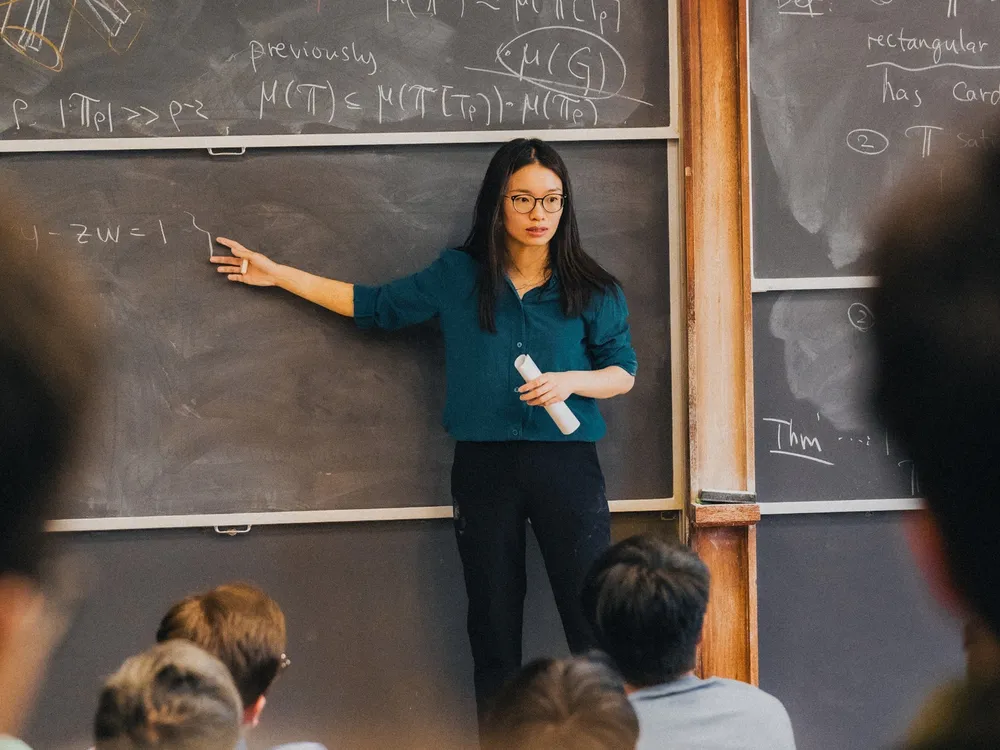Mathematicians Solve Decades-Old Geometry Problem About Spinning a Needle That Had Long Puzzled the Field
Mathematicians Solve Decades-Old Geometry Problem About Spinning a Needle That Had Long Puzzled the Field
A new proof solves the “Kakeya conjecture” in three dimensions, opening up a new set of possibilities for mathematics, from computer science to cryptography
Hong Wang, one of the paper co-authors, presents her work on the Kakeya conjecture.
David Song / NYU
Mathematicians have finally solved a geometry problem that has puzzled the field for decades.
By wiggling a needle around while spinning it, you can minimize the amount of space it moves through, compared to the larger circle traced by turning it around its center.
Claudio Rocchini via Wikimedia Commons under CC BY-SA 3.0
The question was proposed by Japanese mathematician Sōichi Kakeya in 1917. It sounds simple: How can you rotate a needle by 360 degrees in a way that minimizes the amount of space it moves through?
One option would be to rotate it from its center, tracing out a circle with its two ends. But there are smarter ways to go about it. You could also wiggle the needle back and forth while turning it, in a way that forms a triangle with curved edges instead.
“It’s just a problem about how straight lines can intersect one another,” explains Jonathan Hickman, a mathematician at the University of Edinburgh who was not involved in the new work, to Joseph Howlett at Quanta Magazine. “But there’s such an incredible richness encoded in it—an incredible array of connections to other problems.”
Tracing either the circle or the curvy triangle assumes the needle is sitting flat on a desk, in two dimensions. But if you hold the needle up in 3D space and try to rotate it in all directions, the task becomes much harder. To minimize the space it moves through, you’ll need an infinitely narrow needle—and creative math. This puzzle led to the Kakeya conjecture: It states that the number of dimensions of the traced shape will always match the number of dimensions of the space it’s in.
While experts thought this, too, sounded simple, it has taken decades for them to prove it in 3D. Now, mathematicians Joshua Zahl at the University of British Columbia in Canada and Hong Wang at New York University have found the answer to how the needle can move in three spatial dimensions. Their work was recently published as a 127-page preprint article, which has not yet been peer-reviewed, on the arXiv server.
“The paper is perhaps the biggest breakthrough in mathematics of the current century,” says Nets Katz, a mathematician at Rice University who was not involved in the work, to New Scientist’s Alex Wilkins. “It completely resolves a problem that has been attacked by a variety of techniques by a number of the leading figures in the field, most of whom obtained only modest partial results.”Researchers had already proven how the needle could move in one and two dimensions—they figured out one dimension quickly, since nothing can rotate in 1D. Mathematician Roy Davies proved the conjecture in 2D in 1971. But whether a 3D proof existed had remained an open question.
“People understood what’s going on [in Kakeya-adjacent problems] really well in two dimensions, but we lacked the tools to study higher dimensions,” says Wang to Quanta Magazine. “So, I feel like this was necessary. It needed to be done.”
The pair of mathematicians built on previous work by Katz, which established an outline for how the conjecture might be proved in three dimensions. They worked systematically to eliminate each possibility where the number of dimensions of the traced shape would be less than three, writes Scientific American’s Manon Bischoff.
Understanding the three-dimensional Kakeya conjecture can help solve a whole other array of mathematical problems. “This result is not only a major breakthrough in geometric measure theory, but it also opens up a series of exciting developments in harmonic analysis, number theory and applications in computer science and cryptography,” says Guido De Philippis, a mathematician at New York University who was not involved in the research, in a statement.
The next problem for mathematicians to face will be solving the four-dimensional Kakeya conjecture. But with the proof in three dimensions already achieved, the next step might come more easily. “I really think there’s a critical mass of ideas to really revolutionize the whole field coming from here,” Hickman tells Quanta Magazine. “It’s a very, very exciting time.”
Get the latest stories in your inbox every weekday.


